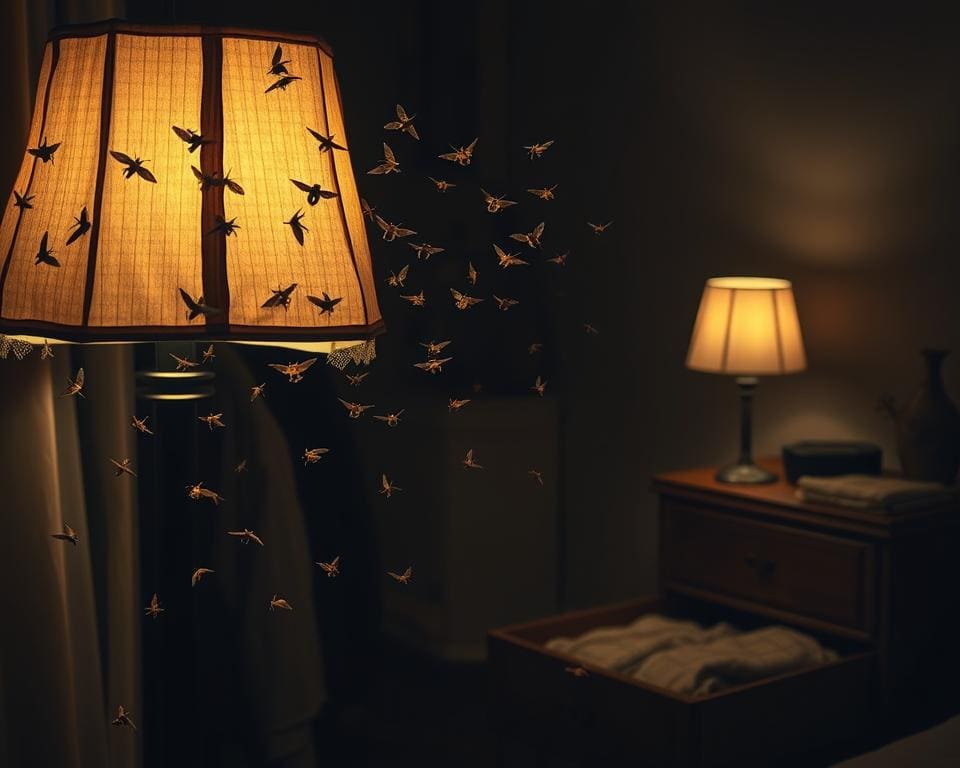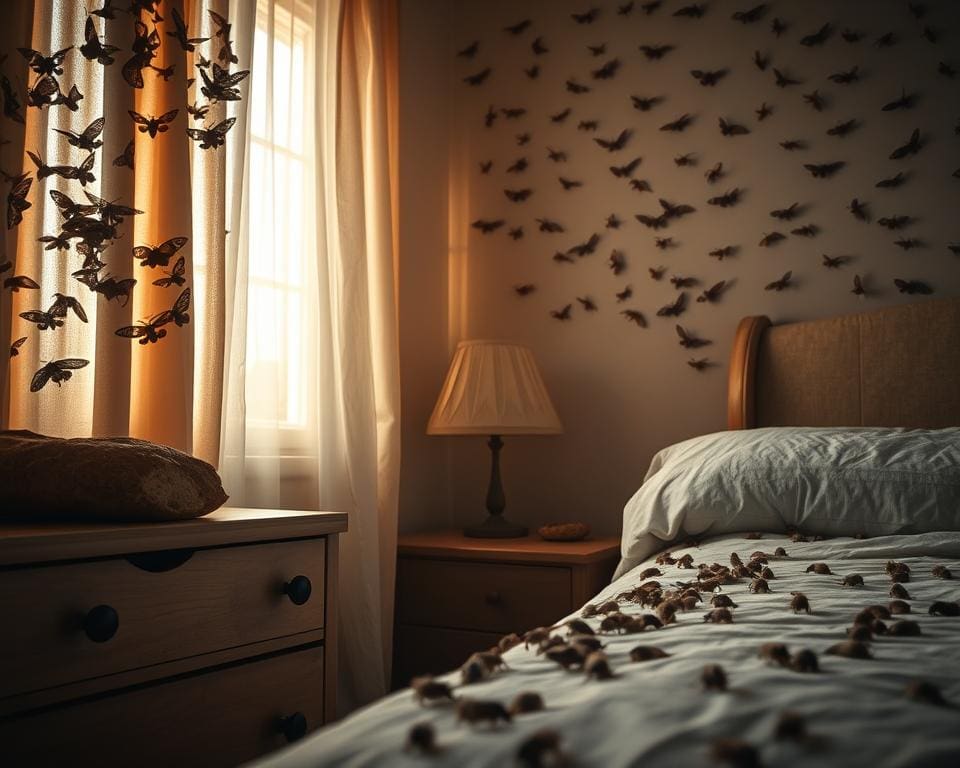Moths are often overlooked yet prevalent intruders in our homes, creating an air of mystery around their whereabouts. Understanding where do moths live in the house is crucial for effective pest control and prevention. Typically, these resilient creatures tend to thrive in areas such as kitchens, wardrobes, and other common moth hideouts in houses, where food and fabrics are stored. By delving into their habits and preferences, homeowners can gain insights into moth habits in homes, equipping them with the knowledge to combat these nuisances and protect their belongings.
Understanding Moth Habits in Homes
The behaviour of moths within our homes reveals much about their life cycle and the challenges they pose as common species found indoors. By recognising their habits, we can better understand how to prevent infestations and protect our belongings.
Life Cycle of Moths
The life cycle of moths consists of four distinct stages: egg, larva, pupa, and adult. Female moths tend to lay their eggs in dark, undisturbed locations, providing a hidden environment for the larvae to develop. Once hatched, the larvae emerge as caterpillars, which actively seek out food sources like natural fibres or stored products. It is during this stage that they cause the most damage. After feeding for a while, the larvae enter the pupa stage, ultimately transforming into adult moths ready to continue the cycle.
Common Species Found Indoors
Several common species found indoors highlight the varying risks associated with moth habits in homes. The Clothes Moth (Tineola bisselliella) is notorious for targeting textiles, particularly clothing made from wool or silk. On the other hand, the Pantry Moth (Plodia interpunctella) poses a threat to food supplies, laying eggs in stored grains, nuts, and dried fruits. Recognising these species enables homeowners to take proactive measures against infestations, thus safeguarding their possessions and pantry items.

Where Do Moths Live In The House
Moths have a fascinating relationship with the interiors of our homes, often choosing locations that perfectly suit their needs. Understanding where do moths live in the house involves exploring their typical nesting behaviour and environmental preferences, which are crucial for prevention and control.
Typical Nesting Behaviour
Moths typically seek out areas that provide shelter and easy access to food sources. Common nesting sites include wardrobes, pantries, and other dark nooks where their presence might go unnoticed. In these spaces, they find safety from disturbances and natural predators. Nesting behaviours often lead them to corners, crevices, and even behind appliances, where they can thrive undisturbed.
Environmental Preferences
The environmental preferences of moths play a significant role in determining their nesting sites. They thrive in conditions characterised by fluctuating temperatures and humidity levels. Areas such as basements and attics provide the ideal environment for moths, offering the darkness they favour for nesting. Understanding these environmental factors can empower homeowners to create less inviting spaces for these creatures.
Moth Nesting Areas Indoors
Identifying moth nesting areas indoors is crucial for effective pest prevention. Moths tend to favour warm, dark environments that are close to their food sources. Understanding where these creatures prefer to establish their homes can empower homeowners to take proactive measures against infestations.
Choosing Ideal Locations
When choosing ideal locations for storing items, consider spaces that are less frequently accessed. Moths thrive in environments where they can remain undisturbed. Common areas include:
- Woollen clothing storage, such as closets and attics.
- Boxes containing old newspapers or magazines.
- Organic material like dried flowers and plant matter.
Infestation Risk Areas
Identifying infestation risk areas within your home is essential. Cluttered environments provide perfect havens for moths to reproduce and flourish. Pay special attention to the following:
- Unused corners filled with boxes and debris.
- Areas with poor ventilation, such as basements and attics.
- Spaces where food or organic materials are left unattended.
Common Moth Hideouts in Houses
Moths are known for their elusive behaviour, often seeking out hidden corners and sheltered areas within homes. Understanding these common moth hideouts in houses allows homeowners to take preventive measures and keep infestations at bay. Identifying secluded spaces helps in targeting potential problem areas effectively.
Identifying Secluded Spaces
Moths favour dark, undisturbed environments where they can safely reside without drawing attention. Commonly overlooked areas include:
- The backs of closets where clothing is stored
- Underneath cabinets and furniture
- Inside boxes or bins in attics and garages
- Behind curtains and under cushions
By focusing on these hideouts, homeowners can take proactive steps to combat moth presence.
Common Rooms Affected
Some rooms in a house are more susceptible to moth infestations than others. The most affected areas often include:
- Bedrooms, particularly in wardrobes
- Kitchens, where food items may attract them
- Laundry rooms with damp textiles
Awareness of these common rooms affected encourages regular inspections, ensuring that moths do not find a permanent residence in the home.
Identifying Moth Infestation Spots
Detecting moths before they cause significant damage is essential for maintaining a healthy home. Identifying moth infestation spots relies on recognising a few key indicators. Early awareness of signs of moth presence allows homeowners to act swiftly and prevent larger outbreaks.
Signs of Moth Presence
Several visible and tangible clues can indicate an infestation. Common signs of moth presence include:
- Adult moths flying around, especially near light sources.
- Larvae found within food items, particularly grains and cereals.
- Damaged clothing, textiles, or furniture, showing small holes.
- Silken webbing in corners, shelves, or along fabric surfaces.
How to Examine Your Home
A thorough home examination aids in finding any potential issues. To effectively examine your home for moths, follow these steps:
- Inspect storage areas, such as closets and attics.
- Check for any signs of webbing or tiny holes in clothing.
- Review kitchen pantries for larvae or damaged food packages.
- Look into furnishings and carpets, focusing on seams and crevices.
Finding Moths in the Home
Effective detection of moths plays a crucial role in maintaining a pest-free environment. Homeowners need to sharpen their observational skills when searching for these elusive insects. Recognising their distinct pale-coloured wings and body shape can aid in quickly identifying moths. Knowing the right approach makes finding moths in the home significantly easier.
How to Spot Moths Effectively
When undertaking the task of moth detection, timing and attention to detail are paramount. Night-time inspections near light sources often reveal fluttering moths, while daylight checks in dim corners are equally important. Maintaining awareness of peak moth seasons enhances the likelihood of spotting them during their active periods. Look closely at clothing and stored materials, as moths are known to hide in fabric folds.
Tools for Detection
Implementing specific tools for detection can remarkably simplify the process of finding moths in the home. Sticky traps serve as an efficient way to monitor moth activity across various areas. Homeowners can strategically place these traps in suspected hotspots to capture and identify any moth presence. Regular inspections paired with these tools will provide valuable insights, enabling timely intervention if infestations occur.
Moth Hotspots in Residential Areas
Understanding where moth hotspots in residential areas occur is essential for effective pest management. Older buildings often contain organic materials that attract moths, making these structures prime locations moths are found indoors. Timber, wool, and even ageing fabrics create inviting environments for these pests, enabling them to thrive.
Moreover, geographical and climatic factors also play a significant role in moth populations. Areas with higher humidity and milder temperatures can foster increased incidences of infestations. Residents in such regions should remain vigilant, particularly during the warmer months when moth activity peaks.
To mitigate the risk of infestations, awareness of these hotspots is crucial. Regular inspections of your home and immediate surroundings, especially in older residences, can help detect early signs of moth presence and ensure prompt action is taken to safeguard your living spaces. This proactive approach ultimately contributes to a comfortable and moth-free home environment.









